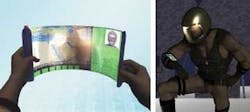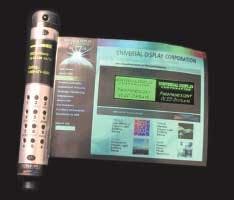Flexible displays open new windows of opportunity
Researchers are working to combine polymer and metal-foil substrates with printable TFT backplanes to move flexible displays closer to commercial reality.
For years, the "holy grail" of the display industry has been a thin, clear, flexible substrate with barrier properties equal to those of a sheet of glass. Flexible displays offer many potential benefits over other display technologies, including reductions in weight and thickness, improved ruggedness, and nonlinear form factors. These features make flexible displays attractive for a variety of electronic products ranging from cell phones and PDAs to computers, toys, electronic books, and "wearables."
The market opportunities for flexible displays are so broad that major electronics, plastics, and printing companies worldwide are investing heavily in the development of polymers, metal foils, and nonthermal manufacturing processes, all geared toward the eventual mass production of flexible liquid-crystal displays (LCDs) and organic-light-emitting-diode (OLED) displays for consumer and military applications. The U.S. Army has even established the Flexible Display Initiative (FDI)—a five-year, $43.6 million university-based manufacturing R&D center designed to speed the commercialization of emissive and reflective display and thin-film transistor (TFT) backplane technologies on polymer and metal-foil substrates (see Fig. 1).
"Imagine a room with electronic wallpaper programmed to display a series of Van Gogh paintings, or a reusable electronic newspaper that could download and display the day's news and be rolled up after use," said Zheng-Hong Lu, a professor in the Department of Materials Science and Engineering at the University of Toronto whose research team has demonstrated OLEDs on a variety of flexible materials, including transparent plastic and reflective metal foil. "It opens up a whole new range of possibilities for the future."
Organic LEDs on glass substrates are already making their way into consumer products such as digital cameras and electric shavers, but the first products to incorporate flexible displays will likely be electronic books, paper, and signage. Philips, E Ink, and Toppan are collaborating on a paper-like e-book they plan to introduce commercially in 2005, while Sony and Matsushita are set to launch their own e-books this year. Also, in December 2003 Xerox spin-off Gyricon (Ann Arbor, MI) released the first commercial application of its SmartPaper technology: the SyncroSign Message Board, a battery-powered wireless-network sign that incorporates a rewriteable display medium originally developed at Xerox Palo Alto Research Center (PARC; Palo Alto, CA).
While all of these products are initially being built on glass substrates, the shift to flexible substrates is under way. Sharp has demonstrated a 4-in. color polysilicon TFT display on plastic with a resolution of 240 × 240 pixels, and Sony and Toshiba reportedly have developed similar technology. In addition, Polymer Vision, a division of Philips, has been able to make organics-based QVGA (320 × 240 pixels) active-matrix displays with a diagonal of 5 in., a resolution of 85 dpi, and a bending radius of 2 cm. The displays combine a 25-µm thick active-matrix backplane containing the polymer electronics-based pixel drivers, with a 200-µm frontplane of reflective "electronic ink" developed by E Ink (see photo, [right]). With nearly 80,000 TFTs, the resulting display is the largest organic electronics–based display yet.
Best approach?
All recent hoopla aside, however, flexible displays are not synonymous with organic LEDs. Engineers have been pursuing various flexible-display technologies for more than 20 years. Each technology has spent a certain amount of time in the limelight as the next solution to the problem of how to produce a display that is flexible, durable, low cost, and also provides adequate resolution, contrast, color, viewing angle, and switching speed. According to Bob Pinnel, chief technology officer at the United States Display Consortium (USDC; San Jose, CA), developers of flexible displays have come to realize there is no single "best" solution—rather, customer requirements tend to determine the most appropriate technology.
The Army's flexible-display initiative, for example, will initially focus on electrophoretics, a low-power-consumption display technology better known for its role in e-paper, e-books, and e-signage. There are currently a handful of commercial e-paper technologies—Gyricon's Smart Paper, for example, is produced in a roll like conventional paper but is actually two sheets of thin plastic with millions of tiny bichromal beads embedded in between. Each bead has a different color on each side, and the hemispheres carry either positive or negative charges. When voltage is applied to the surface, the beads rotate to present one side or the other to the viewer. The image stays in place until a new voltage pattern is applied, which erases the previous image and generates a new one.
E Ink uses stationary microcapsules that contain white particles, black particles, and a clear fluid. When a charge is applied to the capsule, black particles rise to the top—an opposite charge brings the white particles to the top. A third e-paper technology announced last year by Philips Research uses black oil and water trapped in tiny cells to create black and white pixels. An electric charge makes the water push the black oil to the side, exposing a white surface underneath.
Liquid-crystal technology also lends itself to flexible displays such as e-books, although there are performance tradeoffs. Transmissive LCDs, which require an additional lamp to backlight the LCD, are good for high-brightness applications, while reflective LCDs, which offer longer battery life because no additional illumination is needed, are more appropriate for applications involving ambient light, although they suffer from poorer contrast.
Because of their low power consumption, cholesteric LCDs are being pursued for e-books and other potential flexible-display products—Matsushita is already using cholesteric LCDs in its first e-book, The Sigma Book. In the mean time, several groups are working to improve the image quality of these displays. Kent Displays (Kent, OH) is commercializing cholesteric LCD technology that features a bistable, nonvolatile memory to maintain images indefinitely without consuming electrical power and hopes to be producing flexible plastic cholesteric LCDs by 2006. Kent says that the reflective nature of the cholesteric fluid itself yields high contrast, and that high ambient lighting conditions actually improve the contrast, not degrade it.
Nematic LCDs, which rely on bistability to enhance contrast, have been introduced on glass substrates and reportedly will soon be available on polymers as well. ZBD Displays (Worchestershire, England) expects to begin supplying its zenithal bistable displays this year through a collaboration with Varitronix, a leading manufacturer of passive-matrix LCDs. Meanwhile, Solid State Displays (SSD; Austin, TX) is seeking licensees for its polymer-dispersion liquid-crystal technology (PDLC). While PDLC is a mature technology that has been around for years, it has suffered from problems with contrast ratio. But SSD founder Homer Webb has patented a process that adds polarization to PDLCs, yielding a fast-switching field-sequential color display that the company says is well-suited to flexible substrates.
"This is a simple, elegant design that is even better with plastic displays because PDLC is already plastic and there are already manufacturing processes in place for the coating," said James Lupino, director of business development at SSD.
Going organic
Still, when all is said and done, military, academic, and commercial groups alike have their sights set on OLEDs for full-color flexible displays (see Fig. 2). OLEDs are self-luminous and do not require backlighting, polarizers, or diffusers, which reduces the size and weight. In addition, they offer a wide viewing angle and low power consumption. While OLEDs are not yet as bright as other displays, efforts are under way to improve this—scientists at Kodak's Display Technology Laboratory recently announced a transparent, stackable OLED design that yields brighter, more stable color displays. And when it comes to putting OLEDs on polymer or metal-foil substrates, proponents say there is a symbiotic relationship between the materials and the production processes that make OLEDs a natural fit for flexible displays.
"It turns out that the OLED manufacturing process, because it is all chemical, is much more amenable to retaining optimum performance on a flexible surface than other display technologies such as LCDs," Pinnel said. "So the manufacturing costs, in terms of roll-to-roll capabilities, begin to play a major role."
There are still some key technology limitations to be overcome—most notably the extreme sensitivity OLEDs have to moisture and oxygen. While companies such as Universal Display, Philips, DuPont, 3M, and Kyocera are working to commercialize OLED-based flexible displays for a variety of consumer and military products, others are focused on solving the manufacturing problems posed by polymer substrates.
Vitex Systems (San Jose, CA), for example, has developed a vacuum polymer technology that creates a moisture barrier the company says is several orders of magnitude better than conventional inorganic barrier coatings. The company's Barix coating comprises alternating layers of polymer and ceramic thin films that can be deposited on a plastic substrate or directly on a display. According to the company, each inorganic layer is a near-perfect barrier film, and the intervening polymer layers decouple what few defects there are, producing a barrier film that meets the requirements of LCD and OLED displays. Vitex says the layers are so thin that they are flexible enough to be rolled up and still retain their properties—total Barix coating thickness is typically less than 3 µm.
Another key factor in transitioning OLED, LCD, and electrophoretic displays onto polymer or metal involves the TFT backplanes, which must also eventually reside on plastic in order to achieve a truly flexible display. Some research groups are working to modify amorphous silicon TFTs to make it possible to print them at lower temperatures, while others are developing low-temperature polysilicon technologies for backplanes. FlexICs (Milpitas, CA) is marketing ultra-low-temperature (less than 100°C) polysilicon technology that the company says allows TFTs to be fabricated directly on plastic, while SiPix Imaging (Fremont, CA), claims to already have solved the issues related to putting displays on plastic by using submicron pigment microparticles.
Another approach is to eliminate the temperature issue altogether by using organic transistor materials for TFTs that can be printed directly on plastic—researchers at Xerox PARC have developed a technique that uses semiconductor ink and a modified ink-jet printer to put plastic transistors on plastic surfaces, while Plastic Logic (Cambridge, England) is combining its ink-jet plastic electronics capabilities with Gyricon's SmartPaper technology to yield lower-cost e-signage and e-book products on both glass and plastic substrates.
"The big promise with flexible displays is not just the performance features but the ability to significantly reduce the cost," said Janice Mahon, vice president of technology commercialization at Universal Display. "We are looking at evolving from batch processing to roll-to-roll and web-based processing, and there is much work on toolsets right now to enable the production to be done in a roll-to-roll format. More companies, rather than less, are looking at trying to use existing manufacturing capabilities to produce these displays."
REFERENCE
- L. Valigra, Christian Science Monitor 14 (Jan. 8, 2004).
- T. Laboureau, "Flexible e-Paper Technologies," FPD Update, SEMI, 3 (3) (Summer 2003).
- L. S. Liao, K. P. Klubek, and C. W.Tang, Appl. Phys. Lett., 84 (2) 167.



